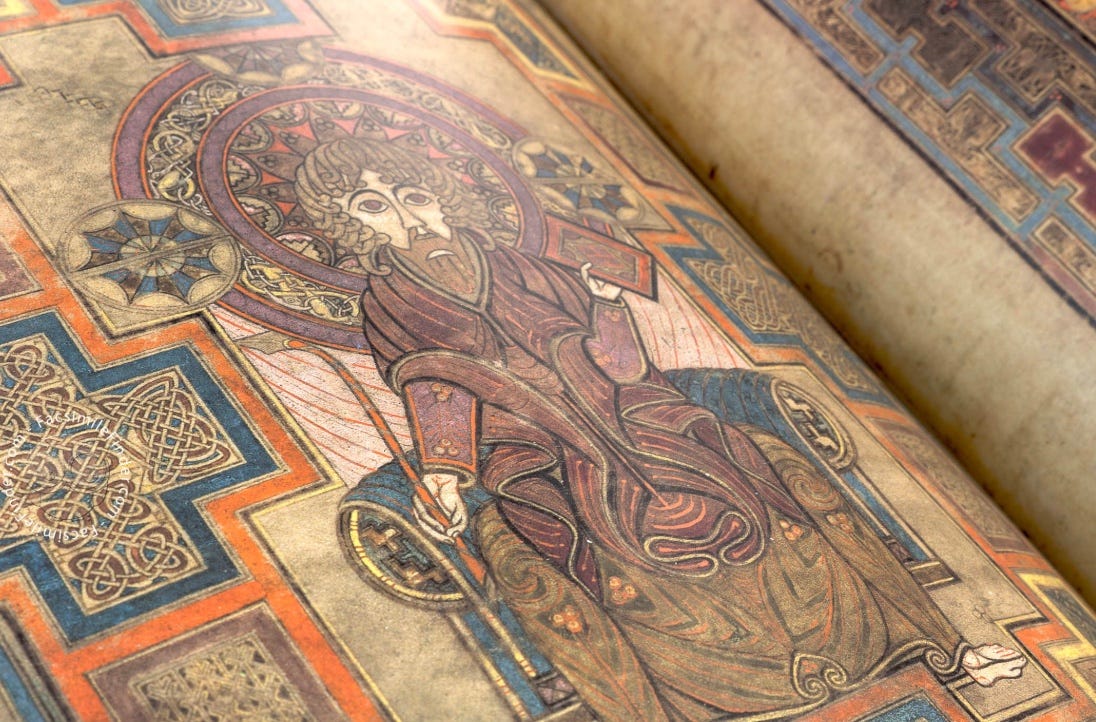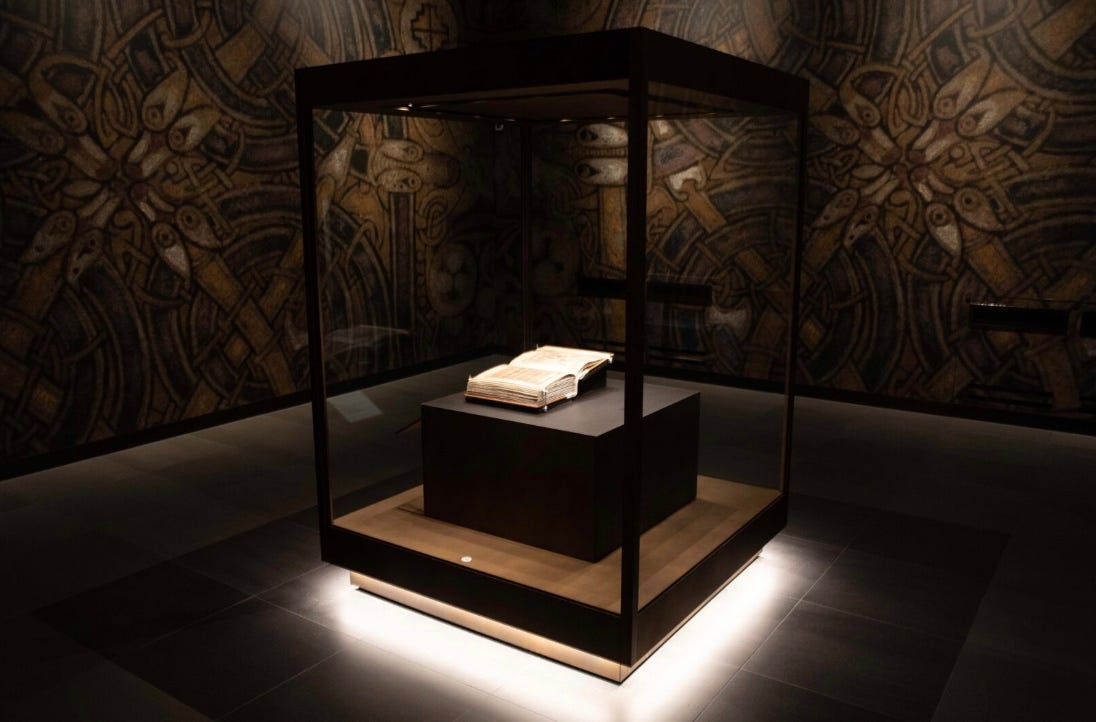In the heart of the capital, far from the wild countryside, I stepped through the archway of Trinity College—a passageway in its own right. The early morning sun lit up the pale Portland stone of the courtyard as I made my way toward the Long Room, toward the illuminated pages of the Book of Kells.
I came early to avoid the crowds, but already a small group stood in line at the door. I took my place and watched students and teachers fanning out to their classes. I pictured those who had walked these grounds before—Jonathan Swift, whose biting satire still echoes through the ages; Samuel Beckett, who stripped language to its bones in search of truth; Theobald Wolfe Tone, who dreamed of an Ireland free and united. Their footsteps lingered, their presence woven into the very fabric of the place, just beneath the surface.
But I had come to see the Book of Kells, a masterpiece of devotion and artistry. In its intricate pages, the old world still speaks—a defiant echo of a time when Ireland’s soul was inked in gold.
Born in the golden age of Irish monasticism, it was crafted by monks who wove scripture into swirling patterns of light and color. These were men who lived in a rhythm of prayer and labour, drawing inspiration from the natural world around them—intertwining vines, leaping beasts, the curling waves of the western sea. But its journey, like Ireland’s own, was marked by upheaval. Likely created on Iona, the sacred isle of St. Columba, it was carried to Kells in Meath in an open boat by monks fleeing a brutal Viking raid in 806 CE. The Vikings, relentless in their pursuit of wealth and power, had already razed monasteries across the coasts of Ireland and Scotland, destroying invaluable centers of learning and scattering their scholars. The monks, knowing the treasure they carried was not of gold but of wisdom, safeguarded the manuscript, bringing it inland to protect it from further plunder.
Can you picture them now? Fleeing across the sea in an open boat, the book wrapped in cloth, protected from the sea spray. Fleeing their home, having to leave behind their fallen friends. They took it to Kells, but even there, however, the book was not entirely safe. The monastery itself was raided multiple times, and in 1007, the Book of Kells was stolen, only to be recovered months later—though its original jeweled cover was lost forever. These cycles of loss and rescue mirror the greater history of Ireland itself, a land that has faced destruction but has always found a way to preserve its soul. There it remained, a guardian of Ireland’s spirit, a book of faith and resilience in the face of destruction.
For centuries, books like this were the lifeblood of Irish monasteries, copied laboriously by hand and sent across Europe as gifts to scholars and kings. In a world teetering on the edge of the Dark Ages, Irish monks became the keepers of learning, the weavers of wisdom. The Book of Kells was more than a manuscript; it was an anchor against the rising tide of destruction, preserving knowledge, faith, and identity through centuries of turmoil. By 1661, in the shadow of Cromwell’s conquest, it was moved again—this time from a besieged church in Meath that then looked like a war zone and held a garrison of Cromwells men to Trinity College, where it would be preserved yet kept at a distance from the very people whose faith had birthed it. Now, of course, anyone can view it, and I had come to do just that.
I had come because I wanted to see, firsthand, the intricate lines of its pages. Those patterns had cast a spell on me. Here was a way of seeing the world that embraced the organic and the natural—the many-textured layers of creation, like rivers carving the land, like the underground currents that had begun to murmur beneath my feet. Somehow, I felt this book carried the same vision. Every line was connected, each thread part of a greater whole. This sense of unity, the interwoven nature of all things, lay at the heart of the monks’ understanding of the world.
More than anything, I wanted to see what effect it would have on me. I hoped that by gazing at its pages, I could look with eyes that were 1,200 years old—and in doing so, root myself more firmly in my own path, my own golden thread, my own line within the greater pattern. This idea of the golden thread—of something luminous linking past and present—is one that I will return to again and again. It is the unseen connection that holds meaning together, that guides us from one place to another, even when we do not yet understand its shape.
Stepping into the Long Room, I felt the weight of history press against me. Like in a cathedral, my eyes were drawn upward to the vaulted ceiling, where row upon row of ancient books reached toward the arches. Lifetimes of work and learning, their presence seemed to hum in the air—another threshold, just beyond the modern world outside, where the city moved through its early workday morning. The room was swimming in this quiet energy. I stepped onto the second balcony, leaning over the wooden railing. Below, visitors murmured in low voices, moving in slow, reverent paths through the library. I paused and closed my eyes, feeling as though the books themselves might start to speak.
I continued on, passing through the first rooms of the museum display for the Book of Kells, but my anticipation did not allow me to linger. I can return later, I decided. First, I want to see the book. Preferably alone.
I entered the dimly lit room where it was housed and caught my first glimpse of the glass case. The book seemed to glow, as if lit from within. Nothing stopped me now. I walked forward and stood before it. My breath stilled. I could have cried.
In an instant, I was a child again, sitting beside the Rye River, peering through the grasses, hoping to catch a silver-brown trout by surprise. And I was back in that field in Sligo, standing beside a man with copper rods in hand, watching them twitch as they traced the hidden water beneath our feet.
I followed the intricate lines of the page, but every time, I got lost. I would start again, and this playful game made me smile. I could almost see the monk’s hand, scribing in solitude on the very edge of the known world. And for a brief moment, I stood beside him, understanding his passion, marvelling at his patience.
I had come for what I sought—to look into the past and find, within it, a more visceral dance with the present.
The Golden Thread—this is what I find myself returning to, time and again. A thread that runs through history, through stories, through the land itself, linking past and present, weaving together those who came before with those who walk these paths now.
So thank you for being here, dear reader, for joining me on the journey. I’m sharing with you the development of this new book, and another reflection, another stream of words flowing into that greater river. Like the monks of old who laboured over their illuminated manuscripts, shaping each line with devotion and care, I am tracing my own lines, letting them weave into something larger.
So much has been lost—entire worlds of knowledge, burned, scattered, forgotten—but what remains is all the more precious. We may never look into the faces of those who safeguarded these treasures, but we can imagine them, and we can be thankful. Their hands, though long vanished, still reach out to us across time, offering glimpses of beauty, wisdom, and faith.








